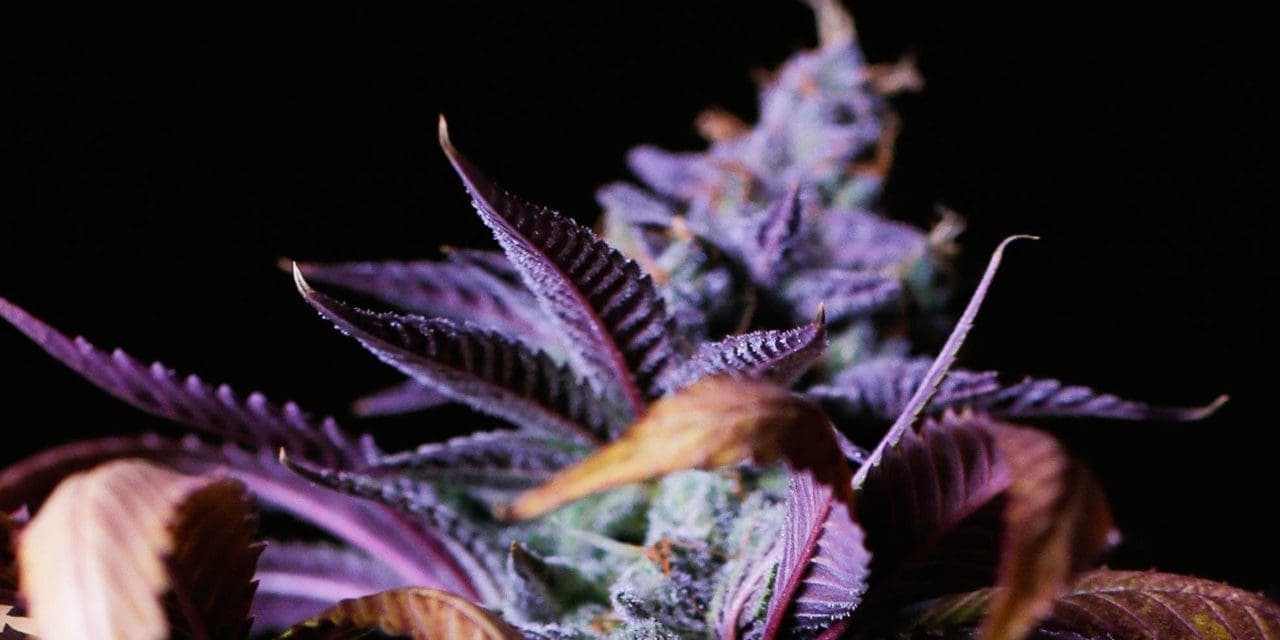Anthocyanin: The Compound That Turns Cannabis Purple

Article written by

Dipak HemrajMedical Cannabis Researcher
Content reviewed by

Dr. Gavin MorelandMedical Director
Anthocyanins are a group of water-soluble plant pigments that, depending on the pH, give some plants a blue, black, red, or purple color. They belong to a parent class of molecules called flavonoids, which contribute to the color and flavor of cannabis and many other fruits and vegetables, such as blue and dark berries, plums, red cabbage, and eggplant (aubergine).
Get your medical marijuana card
What Is Anthocyanin?
Anthocyanins, aka anthocyans, are water-soluble vacuolar (a type of plant cell) pigments. They are flavonoids, and, like many other flavonoids, they have significant anti-inflammatory and antimicrobial properties. Most red, purple, and blue-colored flowers, fruits, and vegetables contain anthocyanins.
Cannabis and Anthocyanins
Anthocyanins are found in cannabis, with some strains (cultivars) containing more pigment than others (e.g., Granddaddy Purple, Purple Diesel). Cannabis growing in colder temperatures (e.g., if it regularly drops below 65 degrees Fahrenheit at night) tend to display more purple anthocyanins. This is because cold breaks down chlorophyll (which is green) and allows anthocyanins to become dominant.
Potential Health Benefits
Anthocyanins have displayed several potential therapeutic and medicinal benefits, including:
- Killing cancer cells: Anthocyanins may help prevent cancer cells from spreading and may actually kill certain cancer cells.
- Protecting against diabetes: Anthocyanins can lower blood glucose and improve insulin resistance, helping to prevent type 2 diabetes.
- Preventing bacterial growth: Anthocyanins effectively prevent the growth of certain forms of bacteria.
- Reducing inflammation: Anthocyanins have been shown to have antioxidant properties and anti-inflammatory effects, reducing the number of free radicals in the body that can lead to oxidative stress and inflammation.
- Preventing cardiovascular diseases (CVDs): Anthocyanins can possibly improve blood lipid profiles which may protect against some forms of heart disease. They may also reduce high blood pressure.
- Protecting against neurodegenerative diseases: While future studies are needed to confirm their neuroprotective effects, some research shows that anthocyanins may be beneficial as treatments for neurodegenerative diseases like Alzheimer’s.
Note that it’s not likely that people smoking marijuana will reap the full benefits of anthocyanins as combusting and smoking cannabis causes the degradation of its compounds. However, you can still gain some benefits and take advantage of the full spectrum of cannabis compounds by making edibles or tinctures out of them.
The other way to take advantage of anthocyanins is by eating fruit and vegetables high in the flavonoid. Examples of anthocyanin-rich foods include:
- Açaí berry
- Blackcurrant
- Aronia (chokeberry)
- Raspberry
- Blueberry
- Redcurrant
- Cherry
- Dark-colored grapes
- Red cabbage
- Purple corn
- Black rice
- Black soybean
And, while not a food, some red wines are shown to have a small amount of this flavonoid. Some anthocyanin supplements on the market claim to be filled with anthocyanin-rich extracts. While they may be helpful, getting your daily dose from whole foods is best.
Popular Purple Cannabis Strains
Popular cannabis strains (cultivars) that don purple anthocyanin pigments include:
- Purple Haze
- Granddaddy Purple (GDP)
- Mendocino Purps
- Grape Ape
- Purple Urkle
- Blackwater
- Purple Kush
- Sour Grape
- Purple Afghani
- Candyland
- Tropicana Cookies
- Purple Skunk
- Black Cherry
- Blueberry
- Purple Punch
- Hawaiian Purple
- Purple Berry
- Obama Kush
- Lavender
- Lavender Jones
- Purple Diesel
- Purple #1
Get Your Medical Card
Frequently Asked Questions
Is purple weed better than green weed?
The anthocyanin content alone will not give you much information about the quality of the cannabis. Many people like the purple, red, blue, or orange hairs on cannabis, as it can look attractive and give a clue as to the strain's flavor.
For example, many purple cannabis varieties contain the terpene linalool, which is a relaxing terpene found in lavender plants. Many people find purple varieties relaxing or sedative, but this is not always the case. So, when it comes to which is better, green or purple, this is very much down to personal preference.